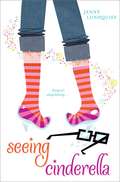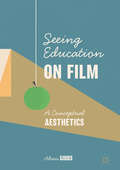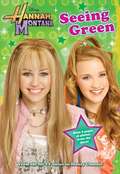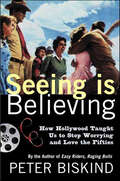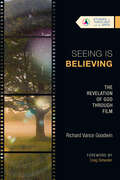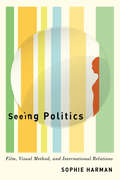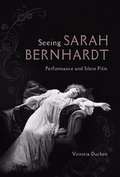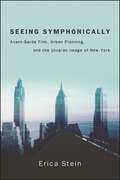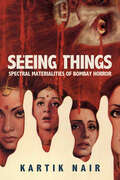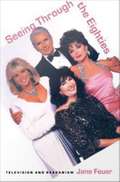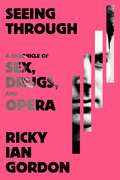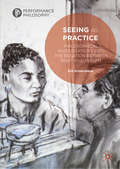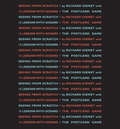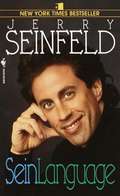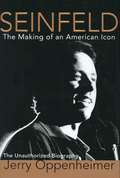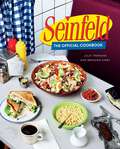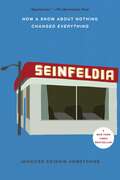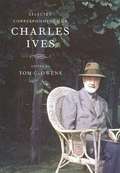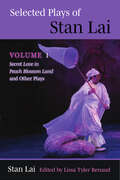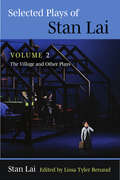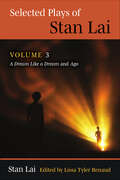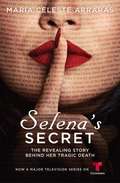- Table View
- List View
Seeing Cinderella
by Jenny LundquistMagical realism and a modern Cinderella story makes for a fun and relatable M!X read.Sixth grade is not going well for Calliope Meadow Anderson. Callie's hair is frizzy, her best friend, Ellen, is acting weird, and to top things off, she has to get glasses. And her new specs aren't even cute, trendy glasses--more like hideously large and geeky. But Callie soon discovers that her glasses have a special, magical perk: When she wears them, she can read people's thoughts. Crazy glasses aside, Callie has more drama to face when she's cast as the lead in the school play--and instead opts to be an understudy, giving the role of Cinderella to Ellen. Can Callie's magic glasses help her see her way to leading lady, or is she destined to stay in the background forever?
Seeing Education on Film: A Conceptual Aesthetics
by Alexis GibbsThis book argues that certain films have more to offer by way of conceptualising education than textual scholarship. Drawing on the work of the later Wittgenstein, it suggests that a shift in our philosophical focus from knowing to seeing can allow for ordinary educational phenomena (teachers, schools, children) to be appreciated anew. The book argues that cinema is the medium best placed to draw attention to this revaluation of the everyday, and particular films are presented as offering unique insights into the aesthetic nature of education as a concept. The book will be of primary interest to educators and educationalists alike, but its interdisciplinary nature should also appeal to those in the fields of film study, philosophy, and aesthetics.
Seeing Green (Disney's Hannah Montana #8)
by M. C. KingEgomaniac! All the girls at Seaview think fellow student and TV actor and Jake Ryan is a hottie, but Miley thinks his ego is out of control. So when he asks her to a school dance, she says no. Then Miley appears as Hannah Montana on his TV series and realizes she might have misjudged him. Before she can admit a change of heart, Jake asks out her friend Lilly! After Miley's jealousy leads to a major fight with Lilly, she realizes she may have lost her best friend and her dream guy! Is it too late to get them back
Seeing Is Believing: How Hollywood Taught Us to Stop Worrying and Love the Fifties
by Peter BiskindSeeing is Believing is a provocative, shrewd, witty look at the Hollywood fifties movies we all love-or love to hate-and the thousand subtle ways they reflect the political tensions of the decade. Peter Biskind, former executive editor of Premiere, is one of our most astute cultural critics. Here he concentrates on the films everybody saw but nobody really looked at--classics like Giant, On the Waterfront, Rebel Without a Cause, and Invasion of the Body Snatchers--and shows us how movies that appear to be politically innocent in fact carry an ideological burden. As we see organization men and rugged individualists, housewives and career women, cops and doctors, teen angels and teenage werewolves fight it out across the screen from suburbia to the farthest reaches of the cosmos, we understand that we have been watching one long dispute about how to be a man, a woman, an American--the conflicts of the period in action. A work of brilliant analysis and meticulous conception, Seeing Is Believing offers fascinating insights into how to read films of any era.
Seeing Is Believing: The Revelation of God Through Film (Studies in Theology and the Arts Series)
by Richard Vance GoodwinHow might film reveal God?In its most basic form, film is a series of images displayed over time. Of course, film has developed greatly since the Lumière brothers by adding components such as sound, special effects, digital recording, and more to create an increasingly complex artistic medium. Historically, film studies has often focused on the narrative aspect of film as it seeks to tell a story. More recent studies, however, have turned attention to other elements of film, such as the musical score. Yet, film remains, in a sense, a series of images.In this study, the latest in IVP Academic's Studies in Theology and the Arts (STA) series, theologian Richard Goodwin considers how the images that constitute film might be a conduit of God's revelation. By considering works by Carl Theodor Dreyer, Stanley Kubrick, Paul Thomas Anderson, Robert Bresson, Martin Scorsese, Terrence Malick, and more, Goodwin argues that by inviting emotional responses, film images can be a medium of divine revelation.Blessed are those who have seen God... through film.
Seeing Politics: Film, Visual Method, and International Relations
by Sophie HarmanPushing the boundaries of how we do research, how we communicate research, and what counts as scholarship in world politics.
Seeing Politics: Film, Visual Method, and International Relations
by Sophie HarmanVisual politics and the aesthetic turn in international relations have emphasized the power of the image in world politics. Postcolonial and decolonial feminist theory shows the urgent need to rethink research and teaching methods. What happens when these concepts converge and such thinking is translated into practice? Engaging with a broad range of topics – the politics of everyday life, health, HIV/AIDS, Africa, post-colonialism, gender/feminist theory, visuality, film, and method – in Seeing Politics Sophie Harman looks at scholars who are pushing the boundaries of how they do research, how they communicate their research to a broader audience, and what counts as scholarship in world politics. Through a detailed exploration of the political process of film production, from inception and co-production to distribution and exhibition, she addresses the tricky transnational relationships, government gatekeeping, and global hierarchies of film governance that control and marginalize the stories and people we see. Fundamentally, Seeing Politics is about how narrative feature film challenges and advances the discipline of international relations, revealing aspects of politics that would otherwise remain unseen and unaddressed. Film is not just a way of communicating research. It is a method that produces research and visibility, advancing research practice and knowledge in international relations. Innovative and compelling, this book is about the politics of seeing, being seen, and what stops us from seeing.
Seeing Sarah Bernhardt: Performance and Silent Film
by Victoria DuckettThe most famous stage actress of the nineteenth century, Sarah Bernhardt enjoyed a surprising renaissance when the 1912 multi-reel film Queen Elizabeth vaulted her to international acclaim. The triumph capped her already lengthy involvement with cinema while enabling the indefatigable actress to reinvent herself in an era of technological and generational change. Placing Bernhardt at the center of the industry's first two decades, Victoria Duckett challenges the perception of her as an anachronism unable to appreciate film's qualities. Instead, cinema's substitution of translated title cards for her melodic French deciphered Bernhardt for Anglo-American audiences. It also allowed the aging actress to appear in the kinds of longer dramas she could no longer physically sustain onstage. As Duckett shows, Bernhardt contributed far more than star quality. Her theatrical practice on film influenced how the young medium changed the visual and performing arts. Her promoting of experimentation, meanwhile, shaped the ways audiences looked at and understood early cinema. A leading-edge reappraisal of a watershed era, Seeing Sarah Bernhardt tells the story of an icon who bridged two centuries--and changed the very act of watching film.
Seeing Symphonically: Avant-Garde Film, Urban Planning, and the Utopian Image of New York (SUNY series, Horizons of Cinema)
by Erica SteinCan the cinema imagine a different way of developing, using, and living in the city? Is it possible to do so using images of the extant city? Seeing Symphonically shows how a group of independent experimental, documentary, and feature films made in and about late modern New York City did just this. Between 1939 and 1964, as the city was being utterly remade by a combination of urban renewal projects, suburbanization, and high-rise public housing, the New York avant-garde reinvented the city symphony, a modernist form that depicted a day in the life of an urban environment through complex montage, optical effects, and street portraiture. Erica Stein documents how these New York City symphonies subverted and critiqued urban redevelopment through their aesthetics, particularly their rhythms, and, through those same rhythms, envisioned a world in which urban inhabitants have the absolute right to remake the city according to their needs, outside the demands of capital.
Seeing Things
by Alan AckermanA technological revolution has changed the way we see things. The storytelling media employed by Pixar Animation Studios, Samuel Beckett, and William Shakespeare differ greatly, yet these creators share a collective fascination with the nebulous boundary between material objects and our imaginative selves. How do the acts of seeing and believing remain linked? Alan Ackerman charts the dynamic history of interactions between showing and knowing in Seeing Things, a richly interdisciplinary study which illuminates changing modes of perception and modern representational media.Seeing Things demonstrates that the airy nothings of A Midsummer Night's Dream, the Ghost in Hamlet, and soulless bodies in Beckett's media experiments, alongside Toy Story's digitally animated toys, all serve to illustrate the modern problem of visualizing, as Hamlet put it, 'that within which passes show.' Ackerman carefully analyses such ghostly appearances and disappearances across cultural forms and contexts from the early modern period to the present, investigating the tension between our distrust of shadows and our abiding desire to believe in invisible realities. Seeing Things provides a fresh and surprising cultural history through theatrical, verbal, pictorial, and cinematic representations.
Seeing Things: Spectral Materialities of Bombay Horror (South Asia Across the Disciplines)
by Kartik NairIn 1980s India, the Ramsay Brothers and other filmmakers produced a wave of horror movies about soul-sucking witches, knife-wielding psychopaths, and dark-caped vampires. Seeing Things is about the sudden cuts, botched makeup effects, continuity errors, and celluloid damage found in these movies. Kartik Nair reads such "failures" as clues to the conditions in which the films were made, censored, and seen, offering a view from below of the world's largest film culture. By combining close analysis with extensive archival research and original interviews, Seeing Things reveals the spectral materialities informing the genre's haunted houses, grotesque bodies, and graphic violence.
Seeing Through the Eighties: Television and Reaganism
by Jane FeuerThe 1980s saw the rise of Ronald Reagan and the New Right in American politics, the popularity of programs such as thirtysomething and Dynasty on network television, and the increasingly widespread use of VCRs, cable TV, and remote control in American living rooms. In Seeing Through the Eighties, Jane Feuer critically examines this most aesthetically complex and politically significant period in the history of American television in the context of the prevailing conservative ideological climate. With wit, humor, and an undisguised appreciation of TV, she demonstrates the richness of this often-slighted medium as a source of significance for cultural criticism and delivers a compelling decade-defining analysis of our most recent past. With a cast of characters including Michael, Hope, Elliot, Nancy, Melissa, and Gary; Alexis, Krystle, Blake, and all the other Carringtons; not to mention Maddie and David; even Crockett and Tubbs, Feuer smoothly blends close readings of well-known programs and analysis of television's commercial apparatus with a thorough-going theoretical perspective engaged with the work of Baudrillard, Fiske, and others. Her comparative look at Yuppie TV, Prime Time Soaps, and made-for-TV-movie Trauma Dramas reveals the contradictions and tensions at work in much prime-time programming and in the frustrations of the American popular consciousness. Seeing Through the Eighties also addresses the increased commodification of both the producers and consumers of television as a result of technological innovations and the introduction of new marketing techniques. Claiming a close relationship between television and the cultures that create and view it, Jane Feuer sees the eighties through televison while seeing through television in every sense of the word.
Seeing Through: A Chronicle of Sex, Drugs, and Opera
by Ricky Ian GordonThe true confessions of a working opera composer: an exhilarating story of "a life that comes out of chaos." At eight years old, Ricky Ian Gordon pulled The Victor Book of Opera off his piano teacher’s bookshelf, and his world shifted on its axis. Though scandal, sadness, and confusion would shake that world over the next few decades, its polestar remained constant. Music has been the guiding force of Gordon’s life; through it, he has been able not only to survive great sorrow but also to capture the depths of his emotion in song. It is this strength, this technical and visceral genius, that has made him one of our generation’s greatest composers.In Seeing Through, Gordon writes with humor, insight, and incredible candor about his life and work: a tumultuous youth on Long Island, his artistic collaborations and obsessions, the creation of his compositions (including The Grapes of Wrath, 27, Orpheus and Euridice, Intimate Apparel, Ellen West, and more), his addictions and the abuses he endured, and the loss of his partner to AIDS and the devastation of the HIV/AIDS epidemic. As Gordon writes of that period: “We were, thousands of us, Lazarus. We had to rise from the ashes. We didn’t have to rebuild our lives, we had to build new ones.” Gordon has succeeded in building a remarkable life, as well as a body of work that bears witness to all he survived in the process—one that will endure as a pivotal chapter in America's songbook.
Seeing as Practice: Philosophical Investigations into the Relation Between Sight and Insight (Performance Philosophy)
by Eva SchuermannThis study provides an overview of philosophical questions relating to sight and vision. It discusses the intertwinement of seeing and ways of seeing against the background of an entirely different theoretical framework.Seeing is both a proven means of acquiring information and a personality-specific way of disclosing the apparent, perceptible world, conditioned by individual and cultural variations. In a peculiar way, the eye holds a middle position between inside and outside of the self and its relations towards itself and others. This book provides a way out of false alternatives by offering a third way with reference to concrete cases of aesthetical and ethical experiences. It will be of particular interest to scholars of the phenomenology and philosophy of perception and it will be valuable to students of philosophy, cultural studies and art.
Seeing from Scratch: Fifteen Lessons with Godard
by Richard DienstTaking as his starting point fifteen characteristically penetrating epigrams by Jean-Luc Godard, Richard Dienst invites us to trace a new path through some of the fundamental questions of cinema. Godard has never stopped offering lessons about seeing and thinking, always insisting that we have to learn how to start over. By starting over "from scratch," Godard challenges us to rethink our ideas about embodied perception, material form and the politics of making images. Less a commentary on Godard's oeuvre than an outline of a Godardian pedagogy, Seeing from Scratch offers a theoretical exercise book for students, teachers and practitioners alike, pursuing unexpectedly far-reaching ways to think through images. Along the way we encounter, in this brief, accessible essay, ideal for classroom use, a wide range of thinkers whose ideas are put to use working through the intellectual and aesthetic questions and challenges Godard's epigrams suggest – not in the abstract, but as part of the book's practical approach to intellectual problem solving. In its conversational tone, return to fundaments and practical pedagogical approach, Seeing from Scratch is an essay for the media age in the mould of John Berger's Ways of Seeing from the 1970s: a new way of discussing the theory and practice of images and the film image. A companion piece, "The Postcard Game," presents a scene from an imaginary classroom, where a stack of postcards – like those found throughout Godard's work – provokes a spiralling series of questions about images, texts and the manifold pathways of the creative process.
Seeing from Scratch: Fifteen Lessons with Godard
by Richard DienstTaking as his starting point fifteen characteristically penetrating epigrams by Jean-Luc Godard, Richard Dienst invites us to trace a new path through some of the fundamental questions of cinema. Godard has never stopped offering lessons about seeing and thinking, always insisting that we have to learn how to start over. By starting over "from scratch," Godard challenges us to rethink our ideas about embodied perception, material form and the politics of making images. Less a commentary on Godard's oeuvre than an outline of a Godardian pedagogy, Seeing from Scratch offers a theoretical exercise book for students, teachers and practitioners alike, pursuing unexpectedly far-reaching ways to think through images. Along the way we encounter, in this brief, accessible essay, ideal for classroom use, a wide range of thinkers whose ideas are put to use working through the intellectual and aesthetic questions and challenges Godard's epigrams suggest – not in the abstract, but as part of the book's practical approach to intellectual problem solving. In its conversational tone, return to fundaments and practical pedagogical approach, Seeing from Scratch is an essay for the media age in the mould of John Berger's Ways of Seeing from the 1970s: a new way of discussing the theory and practice of images and the film image. A companion piece, "The Postcard Game," presents a scene from an imaginary classroom, where a stack of postcards – like those found throughout Godard's work – provokes a spiralling series of questions about images, texts and the manifold pathways of the creative process.
SeinLanguage
by Jerry SeinfeldThose who have watched Jerry Seinfeld's shows will hear his voice in this humorous writing.
Seinfeld: The Making of an American Icon
by Jerry OppenheimerThe never-before-told story of how Jerry Seinfeld made his dream come true -- of how this very ambitious, extremely driven, compulsively perfectionistic carefully worked his way up through the knock-down-drag-out world of stand-up comedy as it began to explode in the mid-1970s, & how he went on to co-create in the late 80s what is considered to be the most successful TV sitcom in its history. From the start, Jerry has been extremely private about all aspects of his personal life. For more than a year, Oppenheimer conducted in-depth interviews with scores of Jerry s closes friends, family members, bus. assoc., lovers, & fellow comedians who spoke candidly, painting a riveting portrait of the beloved & talented comedian.
Seinfeld: The Official Cookbook
by Insight EditionsA Simon & Schuster eBook. Simon & Schuster has a great book for every reader.
Seinfeldia: How a Show About Nothing Changed Everything
by Jennifer Keishin Armstrong"Her book, as if she were a marine biologist, is a deep dive...Perhaps the highest praise I can give Seinfeldia is that it made me want to buy a loaf of marbled rye and start watching again, from the beginning." --Dwight Garner, The New York Times Book Review The hilarious behind-the-scenes story of two guys who went out for coffee and dreamed up Seinfeld--the cultural sensation that changed television and bled into the real world, altering the lives of everyone it touched.Comedians Larry David and Jerry Seinfeld never thought anyone would watch their silly little sitcom about a New York comedian sitting around talking to his friends. NBC executives didn't think anyone would watch either, but they bought it anyway, hiding it away in the TV dead zone of summer. But against all odds, viewers began to watch, first a few and then many, until nine years later nearly forty million Americans were tuning in weekly. In Seinfeldia, acclaimed TV historian and entertainment writer Jennifer Keishin Armstrong celebrates the creators and fans of this American television phenomenon, bringing readers behind-the-scenes of the show while it was on the air and into the world of devotees for whom it never stopped being relevant, a world where the Soup Nazi still spends his days saying "No soup for you!", Joe Davola gets questioned every day about his sanity, Kenny Kramer makes his living giving tours of New York sights from the show, and fans dress up in Jerry's famous puffy shirt, dance like Elaine, and imagine plotlines for Seinfeld if it were still on TV.
Selected Correspondence of Charles Ives
by Tom C. OwensThis volume of 453 letters written by and to composer Charles Ives (1874-1954) provides an insight into one of the most extraordinary and paradoxical careers in American music history. This book opens a direct window on Ives's complex personality and his creative process.
Selected Plays of Stan Lai: Volume 1: Secret Love in Peach Blossom Land and Other Plays
by Stan LaiStan Lai (Lai Shengchuan) is one of the most celebrated theatre practitioners working in the Chinese-speaking world. His work over three decades has pioneered the course of modern Chinese language theatre in Taiwan, China, and other Chinese speaking regions. "The preeminent Chinese playwright and stage director of this generation." (China Daily) "The best Chinese language playwright and director in the world." (BBC) Lai's works include masterpieces of the modern Chinese language theatre like Secret Love in Peach Blossom Land, The Village, and his epic 8 hour A Dream Like A Dream, all of which are in this collection. These volumes feature works from across Lai’s career, providing an exceptional selection of a diverse range of performances. Volume One contains: Secret Love in Peach Blossom Land Look Who's Crosstalking Tonight The Island and the Other Shore I Me She Him Ménage à 13
Selected Plays of Stan Lai: Volume 2: The Village and Other Plays
by Stan LaiStan Lai (Lai Shengchuan) is one of the most celebrated theatre practitioners working in the Chinese-speaking world. His work over three decades has pioneered the course of modern Chinese language theatre in Taiwan, China, and other Chinese speaking regions. "The preeminent Chinese playwright and stage director of this generation." (China Daily) "The best Chinese language playwright and director in the world." (BBC) Lai's works include masterpieces of the modern Chinese language theatre like Secret Love in Peach Blossom Land, The Village, and his epic 8 hour A Dream Like A Dream, all of which are in this collection. These volumes feature works from across Lai’s career, providing an exceptional selection of a diverse range of performances. Volume Two contains: Millennium Teahouse Sand on a Distant Star Like Shadows The Village Writing in Water
Selected Plays of Stan Lai: Volume 3: A Dream Like a Dream and Ago
by Stan LaiStan Lai (Lai Shengchuan) is one of the most celebrated theatre practitioners working in the Chinese-speaking world. His work over three decades has pioneered the course of modern Chinese language theatre in Taiwan, China, and other Chinese speaking regions. "The preeminent Chinese playwright and stage director of this generation." (China Daily) "The best Chinese language playwright and director in the world." (BBC) Lai's works include masterpieces of the modern Chinese language theatre like Secret Love in Peach Blossom Land, The Village, and his epic 8 hour A Dream Like A Dream, all of which are in this collection. These volumes feature works from across Lai’s career, providing an exceptional selection of a diverse range of performances. Volume Three contains: A Dream Like a Dream Ago
Selena's Secret: The Revealing Story Behind Her Tragic Death
by María Celeste Arrarás20th Anniversary Edition An intimate and investigative portrait of beloved Mexican American singer Selena Quintanilla’s murder by Emmy Award-winning journalist María Celeste Arrarás. Now with a new foreword and afterword by the author for the 20th Anniversary Edition.There is no doubt that Yolanda Saldívar pulled the trigger and killed Tejano superstar Selena Quintanilla Pérez on March 31, 1995. But does anyone know what really happened in Room 158 of the Days Inn, moments before the crime took place? María Celeste Arrarás has many answers, and her unrivaled coverage of the murder, trial, and aftermath made her the undisputed expert on the Selena case. Arrarás shares firsthand information about the crime and the people involved—including details of her headline-making jailhouse interview with Yolanda, who repeatedly spoke of “Selena’s secret”—a powerful hidden piece of information that she refused to divulge in the courtroom but revealed to Arrarás at length. Many questions were raised, and not all were answered until this revealing interview shed light on the crime. Why was there a suitcase filled with Selena’s clothes at the murder scene? What was the significance of the jeweled ring, adorned with the initial S that fell from Selena’s bloody fist? Who was the doctor from Monterrey who called himself Selena’s confidant and business adviser? Selena’s Secret fits together the pieces of this puzzle and depicts what really happened on that rainy day in March.
